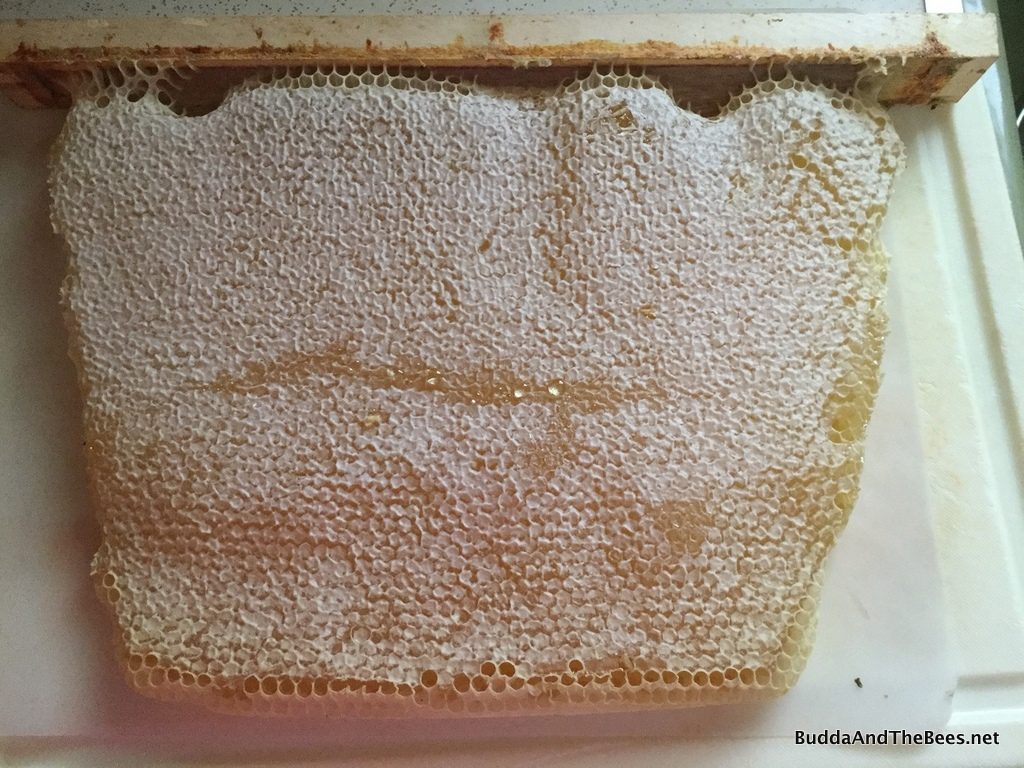One of the things I like about top bar hives is watching the bees build new comb in thin air. I give the bees a bar with a guide on it and they work their magic – building comb down from the top into the space below. No sheet of plastic or pressed beeswax to make them adhere to our standards. They can build in a manner that suits them.They hang down in chains linked by their legs (festooning), imagining the shape of the comb they will build. Most of the time they build with beautiful symmetry, but sometimes they make some wonky comb.

Nice symmetrical comb 
Wonky honey comb
Through time, they appropriate the cells for the needs – some are used for rearing baby bees and are filled with eggs, pollen and honey (brood comb) and some is used solely for storing honey for the coming winter (honey comb). In a top bar hive with an end entrance, the former are usually in the front of the hive, the latter in the back. This allows us to harvest the comb in the back without disturbing the brood nest.
Much of the time when I harvest honey, I’ll take bars out from the back, being sure to leave enough for the bees to get them through the winter. I crush and strain the combs that are misshapen or have turned dark from lots of little bee feet moving over them. But some of the combs are pristine – golden honey capped with white wax. These are saved for comb honey – a delicacy for some people.

The comb honey is cut into squares or rectangles and package in clear boxes so the beauty of the comb can be seen. Comb honey can be spread on toast, served with cheese, dropped in tea, smothered in chocolate – all for the delight of the consumer. It fetches a pretty penny – anywhere from $1.50 to $2 or more/ounce.
This winter, two of my hives died – one from unknown causes (although I think they got overwhelmed by yellow jackets), the other from beekeeper stupidity. I had closed up the entrance too tightly and the hive was sealed too well, that moisture built up and the bees froze to death. Every year, there’s a new lesson to learn.
The upside of the death of a hive is that it’s resources can be used for future colonies. It takes about 8 pounds of honey to produce 1 pound of wax, so prebuilt wax combs are a boon to a new colony. But there is also honey (and wax) to be had by the beekeeper. Some of it can be saved to feed new colonies, but the rest can be bottled or cut up into comb honey.
With the death of the latest colony, I have been able to box up some comb honey. The rest will be crushed for bottling. And the leftover filtered wax will be melted down for making candles and other products.

Yum! 
12.5 oz 
12.5 oz box 
6 oz 
6 oz box
We are working on setting up our on-line store to sell pure beeswax candles, lip balms, personal care products and (seasonally) honey soon. Stay tuned!










2 Comments
HB · January 25, 2021 at 1:17 am
I am sorry to hear of your winter losses — our friend Marty reports three hives lost already — but excited that you were able to harvest some truly gorgeous looking honeycomb! My favorite way to eat it is on oatmeal. A pretty chunk of comb honey converts a rather unspectacular meal into something special.
Don · January 26, 2021 at 3:33 pm
People are always asking me how to use it, so I’ll add that to the list! Losses don’t bother me as much as they used to (especially when I can salvage the honey), but these were stupid mistakes on my part so it’s also a learning experience. Just start again in the spring – it’s not that far off!